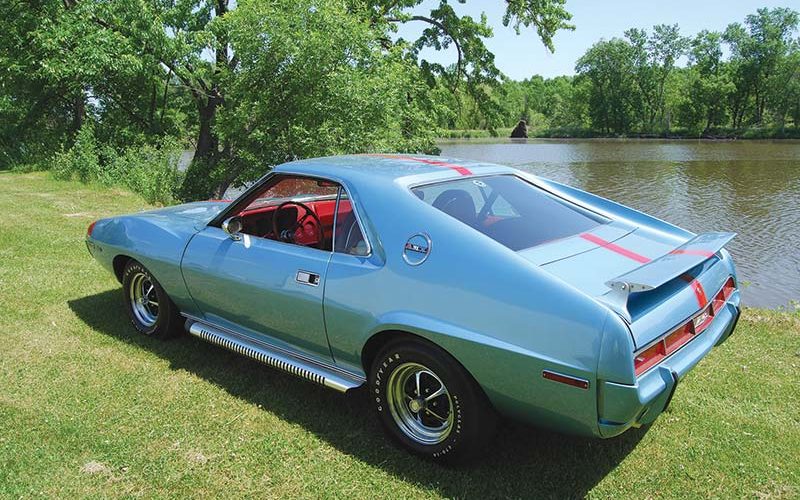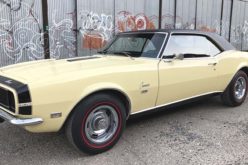Richard Teague’s Street Car became a Dream Car


Car designer Richard A. Teague had developed a love of two-seat cars in the ‘50s. One of his earliest two-seaters was a hardtop convertible designed for Kaiser-Frazer in 1946. In the early ‘50s he worked at Packard. A handful of 1954 Packard Panther Daytonas represented another of Teague’s concepts for a sporty two-seater.
In 1964, when he was only 40 years old, Teague was elevated to vice president in charge of AMC styling. Teague had studied at Art Center School of Design in Pasadena, Calif., where the focus was on form and line, not tinsel. By the ‘60s, he was known as “Mr. Clean” in the industry. Car Life said he represented “fresh air amidst an atmosphere of the all-too-common ‘design by committee’ school of styling.” Teague favoured less flamboyance and exterior ornamentation on cars. He saw clean design as a “maturing of aesthetics,” as well as a safety enhancement with fewer doo-dads to impale pedestrians.
“Teague has brought a young man’s outlook to Detroit’s styling studio,” wrote Gene Booth in the June 1964 issue of Car Life. The designer had a good handle on industrial design and accurately predicted to Booth that bucket seats, fastback roofs and performance engine modifications would become big trends between 1964 and 1974.
In 1965, Teague discussed the early ‘60s upswing in his company’s fortunes and recent changes in the car buying habits. “Stimulated by a taste of variety and bolstered by continued national prosperity, the car buyers of this nation began asking for more,” he said. “They wanted full freedom of choice—custom ordering or as close as possible to it.”

AMC boss Roy Abernethy had fought to resist the muscle car market. This attitude continued to rule as long as AMC was doing well selling small, economy cars. Problems arose when he started a movement to larger AMC cars that he liked. These did not sell very well, while pony cars expanded from 11.2 percent of market in 1966 to 14.6 in 1967.
“I decided to do a really hot two-seat car—one like Ferrari would do,” Teague told Motor Trend. “But instead of (making) 10 a year, we’d design it so we could build 10,000.” Teague wanted the AMX to have a rumble seat, but said, “They (management) looked at me like I was from the moon.” Still, a working model of the AMX was approved and built by Vignale in Turin, Italy. It debuted at the 1966 New York International Auto Show.
About the same time, Detroit industrialist Robert B. Evans bought 200,000 shares of AMC stock. He became the firm’s largest shareholder and was elected to the board of directors. Evans soon revealed AMC was going to build a production version of the AMX.
Victor G. Raviolo was in charge of AMC creative projects in 1967 and made rapid changes. He told Car Life he had watched women and their reactions to changes in skirt lengths. “The skirts got shorter and women who were 40-50 years old said that wasn’t for them,” he pointed out. “But the next year, you see those women and their skirts are a little shorter. This is the influence of young people—they pull the rest of the market with them.”

Although it was good looking, hot performing and innovative, the AMX never captured the fancy of young car buyers the way that the Mustang had. Only 6,725 were sold in 1968, followed by a slight–and very temporary increase–in 1969, when the number rose to 8,293. Then, in 1970, the total fell to 4,116. The car was not selling as hoped and other factors were shrinking its future market potential.
When America adopted the 1970 Clean Air Act, it sealed the fate of pony cars with high-compression V8s. Design studios kept their “Help Wanted” signs hidden. Keith Teter, head of the Industrial Design Department at the Art Center College, reported his graduates were being hired to do snowmobiles, boats, trailers and ATVs instead of cars.
At AMC, president Bill Luneberg informed Dick Teague that the two-seat AMX was going to be dropped after 1970. Luneberg was a production man and knew the extra work involved in building the two-seater was not justified by its sales. Teague wanted to convince AMC to continue building the two-seater, so he customized his own AMX.
Teague’s car was a stock early production Rally Green Metallic car with a black vinyl interior, a 390-cid 315-hp V8 and automatic transmission. Teague painted the front bumper white, installed ’67 Plymouth Valiant turn signal lamps, bolted on a front spoiler and added 8-in. Kelsey-Hayes wheels, a Sidewinder exhaust system and a customized fuel filler on the left-hand sail panel. Other touches included competition style hood-locking pins, twin longitudinal racing stripes, special 390 badges and a red interior with armrest.
Some of the changes like the painted bumper became a production option on AMC’s “Big Bad” trimmed cars. To get the racing stripes, AMC buyers could specify the ’68 Go-Package option. The Tadco-made Sidewinders were a ’69 option. Later, Javelin Trans Am and AMX models adopted the “chin” type front spoiler.
Teague knew AMC was planning a four-seat Javelin-AMX and planned to give the Javelin new front and rear ends on a longer wheelbase, without altering outer door panels, windshield, unibody and trunk lid. He dusted off his custom AMX, which he hadn’t used for a while, added a ‘71 Javelin fibreglass mockup front clip, adopted bulging fender lines designed by Eric Kugler and added red T-stripes that were already set for production.

In essence, he turned his personalized AMX into a ’71 concept car. Teague showed his “1971 styling prototype” to the AMC board of directors on Nov. 4, 1969. The design was rejected, which was no big surprise. Teague had not had the time or money to integrate front and rear styling, but the interior did get some additional consideration.
Teague kept the car. He later gave it to his son Rich as a high school graduation gift. Rich traded it in on a Gremlin. The car was then drag raced on Woodward Ave., before Unique Motorcars in Rockford, Ill., restored it. It almost went to a museum in 1975, but wound up with a teenager who drove it for five years and stored it in a garage in Whitewater, Wis. Don Loper, of the American Motors Owners Assoc. (www.amonational.com) heard about the car. In 1985, Loper told AMC collector Mike Spangler that Teague’s design car was less than 15 miles from his Jefferson, Wis., home.

Rich Teague damaged the fibreglass hood and hood scoop and substituted a flat steel hood. Spangler located an enthusiast in Oregon who reproduces the scoops in fibreglass. Spangler replaced the damaged rear spoiler with a reproduction spoiler for a Trans Am Javelin. He says just about everything else matches the prototype.
Teague died in 1991, before Spangler finished his restoration, which took until 1999 to complete. Former AMO president Darryl A. Salisbury asked Mike Spangler to finish the car for the Eyes on Design show in Detroit, which was doing a Teague tribute. Spangler worked hard to put it back to its Nov. 4, 1969 configuration by show time.
Spangler stores the car at his AMC museum in Jefferson, where he has two large buildings filled with AMC cars, dealership memorabilia, literature and petroliana. During the twice-a-year Jefferson Swap Meets, he sells parking spaces on his land opposite the swap area and shows his collection to dozens of guests and visitors. Each spring he also hosts a Graduation Car Show and Pig Roast for Nash, Hudson and AMC models, plus other types of cars. He and his wife Cheryl are also VIPs in the American Motors Owners Assoc. Mike is definitely the best person there is to be taking care of Dick Teague’s AMX.
















